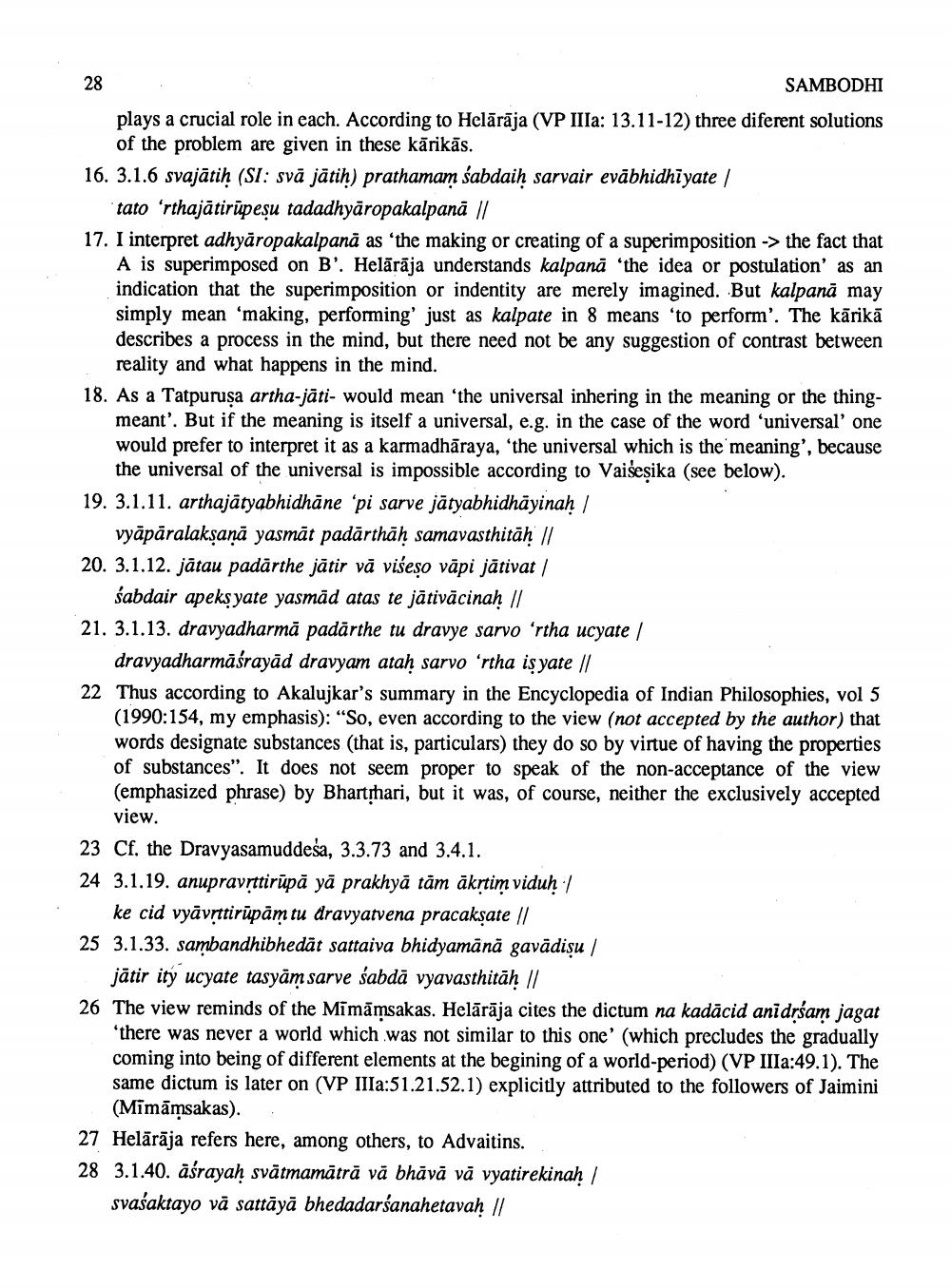________________
28
SAMBODHI plays a crucial role in each. According to Helārāja (VP IIIa: 13.11-12) three diferent solutions
of the problem are given in these kārikās. 16. 3.1.6 svajātiḥ (SI: svā jātih) prathamam śabdaiḥ sarvair evābhidhiyate |
tato‘rthajātirūpesu tadadhyāropakalpanā || 17. I interpret adhyāropakalpanā as 'the making or creating of a superimposition -> the fact that
A is superimposed on B'. Helārāja understands kalpanā 'the idea or postulation as an indication that the superimposition or indentity are merely imagined. But kalpanā may simply mean 'making, performing' just as kalpate in 8 means 'to perform'. The kārikā describes a process in the mind, but there need not be any suggestion of contrast between
reality and what happens in the mind. 18. As a Tatpurusa artha-jäti- would mean 'the universal inhering in the meaning or the thing
meant'. But if the meaning is itself a universal, e.g. in the case of the word 'universal' one would prefer to interpret it as a karmadhāraya, 'the universal which is the meaning', because
the universal of the universal is impossible according to Vaisesika (see below). 19. 3.1.11. arthajātyabhidhāne 'pi sarve jātyabhidhāyinah /
vyāpāralaksaņā yasmāt padārthāh samavasthitāḥ // 20. 3.1.12. jātau padārthe jātir vā višeşo vāpi jātivat /
sabdair apeks yate yasmäd atas te jātivācinaḥ // 21. 3.1.13. dravyadharmā padārthe tu dravye sarvo ‘rtha ucyate /
dravyadharmāśrayād dravyam ataḥ sarvo ‘rtha iş yate | 22 Thus according to Akalujkar's summary in the Encyclopedia of Indian Philosophies, vol 5
(1990:154, my emphasis): "So, even according to the view (not accepted by the author) that words designate substances (that is, particulars) they do so by virtue of having the properties of substances". It does not seem proper to speak of the non-acceptance of the view (emphasized phrase) by Bhartshari, but it was, of course, neither the exclusively accepted
view. 23 Cf. the Dravyasamuddeša, 3.3.73 and 3.4.1. 24 3.1.19. anupravrttirūpā yā prakhyā tām ākrtim viduh/
ke cid vyāvrttirūpām tu dravyatvena pracakṣate // 25 3.1.33. sambandhibhedāt sattaiva bhidyamānā gavādişu /
jātir ity ucyate tasyām sarve sabdā vyavasthitäh // 26 The view reminds of the Mimāmsakas. Helārāja cites the dictum na kadācid anidrśam jagat
'there was never a world which was not similar to this one' (which precludes the gradually coming into being of different elements at the begining of a world-period) (VP IIIa:49.1). The same dictum is later on (VP IIIa:51.21.52.1) explicitly attributed to the followers of Jaimini
(Mīmāmsakas). 27 Helārāja refers here, among others, to Advaitins. 28 3.1.40. aśrayah svätmamātrā vă bhāvā vă vyatirekinah /
svasaktayo vā sattāyā bhedadarśanahetavah //




